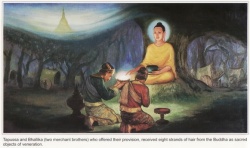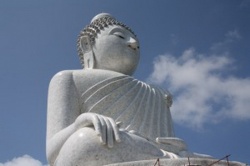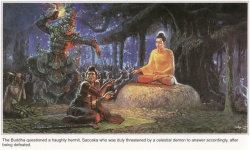The Fourth Jhāna (Catuttha Jhāna)
The the Padīpopama Sutta:
Therefore, monks, if a monk wishes, “May I, with the abandoning of pleasure and pain, and with the earlier passing away of happiness and unhappiness, enter and remain in the fourth jhāna, which is without pleasure or pain, and includes the purity of equanimity and mindfulness,” this same concentration through mindfulness of breathing should be closely attended to.
This is the full unified attainment of jhāna. It’s the complete unification of the whole body with pure, bright awareness. Mindfulness and full awareness are now as clear and refined as possible. This is the purity of mindfulness which is the culmination of the development of right effort, right mindfulness, and right concentration. The Kāyagatāsati Sutta continues:
Just as if a man were sitting covered from head to foot with a white cloth so that there would be no part of his body to which the white cloth did not extend; so too, the monk sits permeating the body with a pure, bright mind so that there is no part of his whole body that is not permeated by this pure, bright mind.
Here too we can clearly see the concomitant mental factors that are present. This requires a very precise balance between calm and clear seeing. If one absorbs too deeply into the quality of calm it will impair the mind’s ability to engage in clear seeing. The Anupada Sutta:
Whatever phenomena there are in the fourth jhāna: equanimity, neither-painful-nor-pleasurable feeling, unconcern due to tranquility of mind, purity of mindfulness, singleness of mind, contact, feeling, recognition, intention, mind, desire, decision, energy, mindfulness, equanimity, and attention; he defined them one by one as they occurred. Known to him they arose, known to him they remained, known to him they subsided.
At this point, or indeed at any point after the stabilization of the first jhāna, we can apply discernment (paññā), according to whichever of the three characteristics we choose to contemplate. This involves clearly seeing conditioned phenomena of body and mind as being impermanent, unsatisfactory, and therefore not-self. The Jhāna Sutta:
Here a monk ... enters and remains in the first ... second ... third ... fourth jhāna.... He sees whatever phenomena there that are connected with form, feeling, recognition, fabrications, and consciousness, as impermanent, as unsatisfactory, as a disease, as a cancer, as a dart, as painful, as an affliction, as alien, as disintegrating, as emptiness, as not-self.
He turns his mind away from those phenomena, and then directs it towards the death-free component, ‘This is peace, this is excellent: the calming of all fabrications, the release of all acquisitions, the elimination of craving, dispassion, cessation, nibbāna.’
Phrased in terms of the discernment of the four noble truths resulting in the ending of the mental outflows (āsavas), this fruitional insight process is articulated in DN 2 Samaññaphala Sutta. After describing the fourth jhāna, and the five mundane higher gnoses (lokiya abhiññā) that can arise from mastering the four jhānas, the discourse goes on to describe the supramundane higher gnosis (lokuttara abhiñña) of complete liberation, which is the extinction of the mental outflows. This liberation is described as occurring while still employing the same level of concentration as the fourth jhāna. It’s important to remember that the first noble truth includes the five aggregates of clinging:
With his mind thus concentrated, purified and cleansed, unblemished, free from impurities, pliant, malleable, steady, and attained to imperturbability, the monk directs and inclines it to the knowledge of the elimination of the mental outflows. He understands as it really is that, ‘This is unsatisfactoriness... This is the origination of unsatisfactoriness... This is the cessation of unsatisfactoriness... This is the way leading to the cessation of unsatisfactoriness....’
Thus knowing, thus seeing, his mind is liberated from the mental outflow of sensual pleasure, the mental outflow of becoming, the mental outflow of ignorance. With liberation there is the gnosis, ‘liberated.’ He understands that, ‘Birth is ended, the holy life fulfilled, done is what had to be done, there is nothing further here.’
DN 22 Mahāsatipaṭṭhāna Sutta gives the standard formula for the fourth jhāna as follows:
With the abandoning of pleasure and pain, and with the earlier passing away of happiness and unhappiness, he enters and remains in the fourth jhāna, which is without pleasure or pain, and includes the purity of equanimity and mindfulness.
SN 48.40 states that the happiness faculty (somanassindriya) ceases in the fourth jhāna. What remains is both bodily and mental equanimity (kāyika and cetasika upekkhā) as stated in SN 48.37, which DN 9 calls an actual refined recognition of neither pleasure nor pain (adukkhamasukhasukhumasaccasaññā).
Again, this agrees with Peṭakopadesa 7.72:
In the first jhāna the pain faculty ceases and in the second jhāna the unhappiness faculty ceases, so with the abandoning of pleasure and pain, and with the earlier passing away of happiness and unhappiness, he enters and remains in the fourth jhāna, which is without pleasure or pain, and includes the purity of equanimity and mindfulness.
measurelessmind.ca
Here [previously] equanimity was still not clarified due to the presence of the four faculties, namely the pain faculty, the unhappiness faculty, the pleasure faculty, and the happiness faculty. With the cessation of these there is equanimity and full awareness.
Here, it was due to the pleasure faculty and the happiness faculty that there was a lack of mindfulness, and with their cessation he becomes possessed of mindfulness. And it was due to the pain faculty and the unhappiness faculty that there was a lack of full awareness, and with their cessation he becomes fully aware. So with the clarification of equanimity, [which is accompanied by neither-painful-nor-pleasant feeling,] he becomes mindful and fully aware, and there is singleness of mind. This is called the fourth jhāna.


